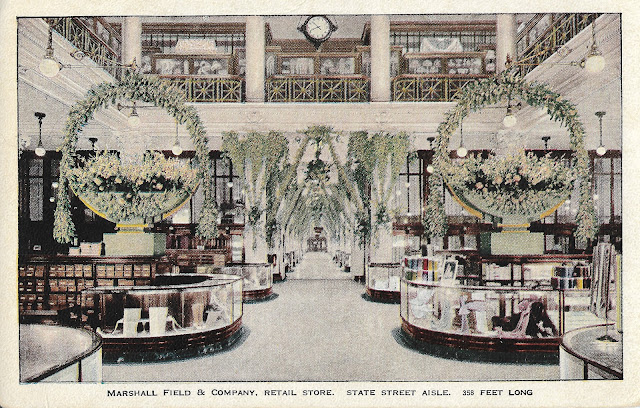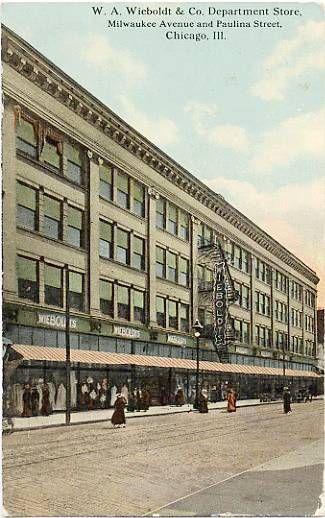 |
| Marshall Field & Company's State Street store decorated for the Christmas Holiday. Postcard publisher is unknown. |
Cinnamon
Bear’s official name was Paddy O’Cinnamon, and he spoke with an Irish brogue. The
show consisted of 26 15-minutes episodes and told the story of how the bear helps lead a pair of twins to Maybe Land to search for a silver star. Cinnamon Bear also had a short run as a TV show in
1951, with twins Judy and Jim being played by child actors alongside a Cinnamon
Bear hand puppet. The illustrated book The Cinnamon Bear in the Adventure of
the Silver Star was published in 2007, and the story was also remade into a
podcast released by Audible this year.
 |
| W.A. Wieboldt & Company Department Store on Milwaukee Ave. and Paulina St. in Chicago. Postcard publisher in unknown. |
Meanwhile, Chicago-based department store Montgomery Ward had been publishing books to give out for free to children visiting the store during the holiday season. In 1939, a catalog writer at the store by the name of Robert L. May submitted a manuscript about an outcast reindeer with a red nose who grows up to become a hero when he leads Santa’s sleigh. Rudolph the Red-Nosed Reindeer became that year’s book giveaway. The story was a hit, and Montgomery Ward gave away over two million copies of the book that year.
Almost a
decade after the book was first published, Montgomery Ward gave May the rights to the story. May collaborated with
his brother-in-law Johnny Mark, a professional composer, to write a song to go
along with the book. The song was picked up by Gene Autry and became a
chart-topping hit in 1949. In 1964, the stop-motion animated special Rudolph
the Red-Nosed Reindeer aired on TV, and it has become one of the
longest-running Christmas TV specials in history.
 |
| Montgomery Ward & Company once had the largest department store building in the country; it was located on the Chicago River. Postcard publisher is unknown. |
To compete with Wieboldt's and Montgomery
Ward, Marshall Field’s created the Uncle Mistletoe character to lift spirits
and encourage sales during the Christmas season. Uncle Mistletoe was a
jolly-looking, white-haired man with a black top hat, red coat, and a pair of
wings which he would use to fly around the world to teach children about the
importance of kindness. Uncle Mistletoe was first featured in the Marshall
Field’s Christmas window display in 1946, and in 1948 the character Aunt Holly
was created to accompany Uncle Mistletoe on his adventures. The pair became a
merchandising bonanza, and Marshall Field’s sold Uncle Mistletoe and Aunt Holly
toys, books, ornaments, and other products.
While the Cinnamon Bear, Uncle Mistletoe, and Aunt Holly never came to enjoy the
widespread fame of Rudolph the Red-Nosed Reindeer, all of these characters were
known to bring joy to both children and adults at Christmastime.
Sources:
Robin Amer, “In ‘Uncle Mistletoe, TV ephemera from Marshall Field’s golden age,” WBEZ (March 10, 2012), www.wbez.org/stories/in-uncle-mistletoe-tv-ephemera-from-marshall-fields-golden-age/ee872264-51d4-4dbe-9b75-082ec953a8ef.
“The History of Rudolph the Red-Nosed Reindeer,” NPR Morning Edition (Dec. 25, 2015), www.npr.org/2015/12/25/461005670/the-history-of-rudolph-the-red-nosed-reindeer.
Leslie Goddard, “For Generations of
Chicagoans, Marshall Field’s Meant Business, and Christmas,” Smithsonian
(Dec. 19, 2016), www.smithsonianmag.com/history/ generations-chicagoans-marshall-fields-meant-businessand-christmas-180961499/.
Michelle Delgado, “The Magical Animation of ‘Rudolph the Red-Nosed Reindeer,’” Smithsonian (Dec. 23, 2019), www.smithsonianmag.com/innovation/magical-animation-rudolph-red-nosed-reindeer-180973841/.
Cinnamon Bear website, www.cinnamonbear.org.
Wikipedia, “The Cinnamon Bear,” https://en.wikipedia.org/wiki/The_Cinnamon_Bear.
Wikipedia, “Wieboldt’s,” https://en.wikipedia.org/wiki/Wieboldt%27s.
There was a time limit when mobile gamblers didn’t get to experience the great world of SM카지노 live casinos. However, know-how has advanced tremendously since then, and gamblers who choose to play casino video games on their mobile units are now not out of the loop. In fact, most live casino developers are making an effort to ensure mobile compatibility. Before diving into the primary reasons why why} live casinos are so popular, let’s first speak a bit about live casinos generally.
ReplyDelete